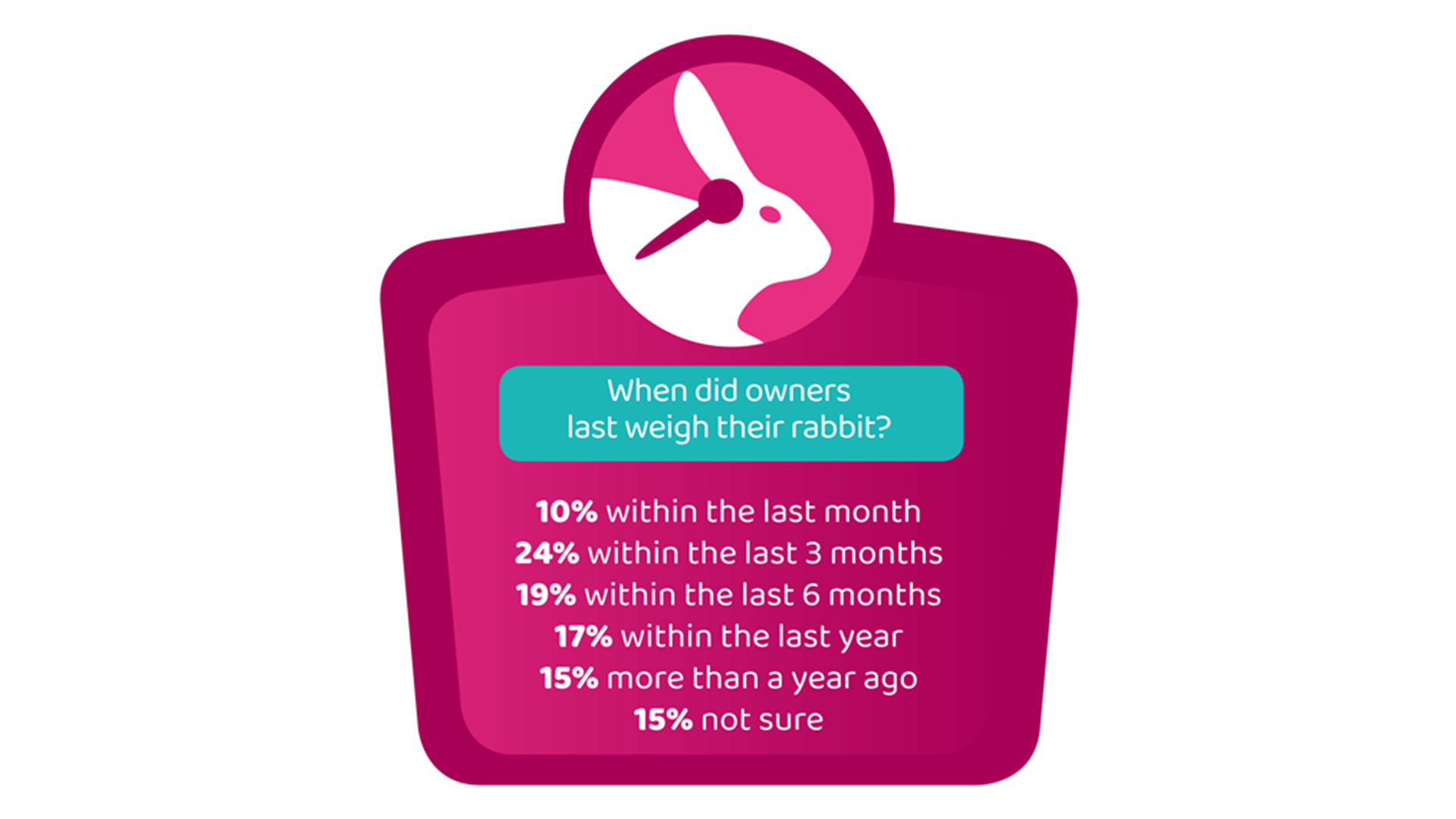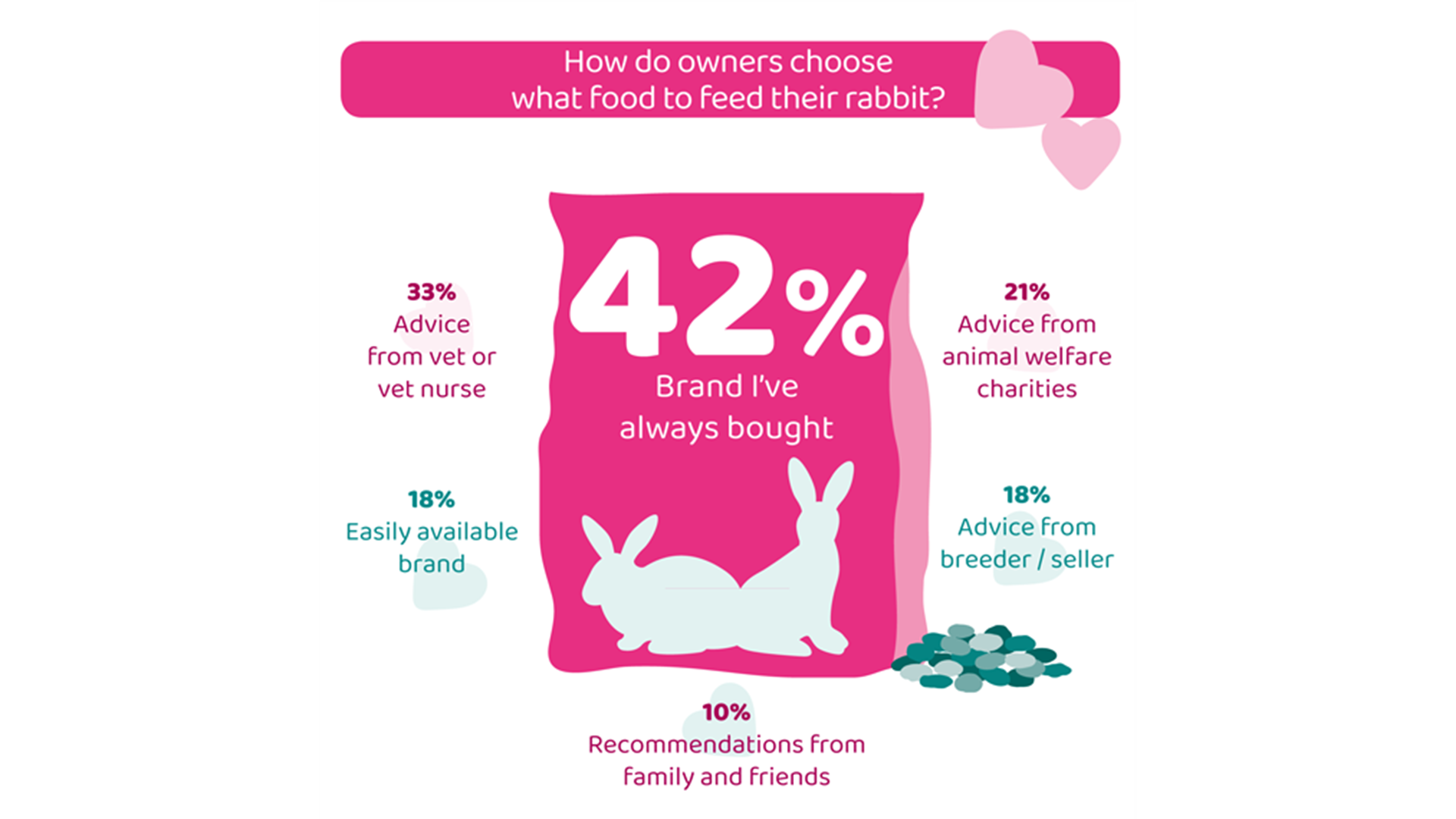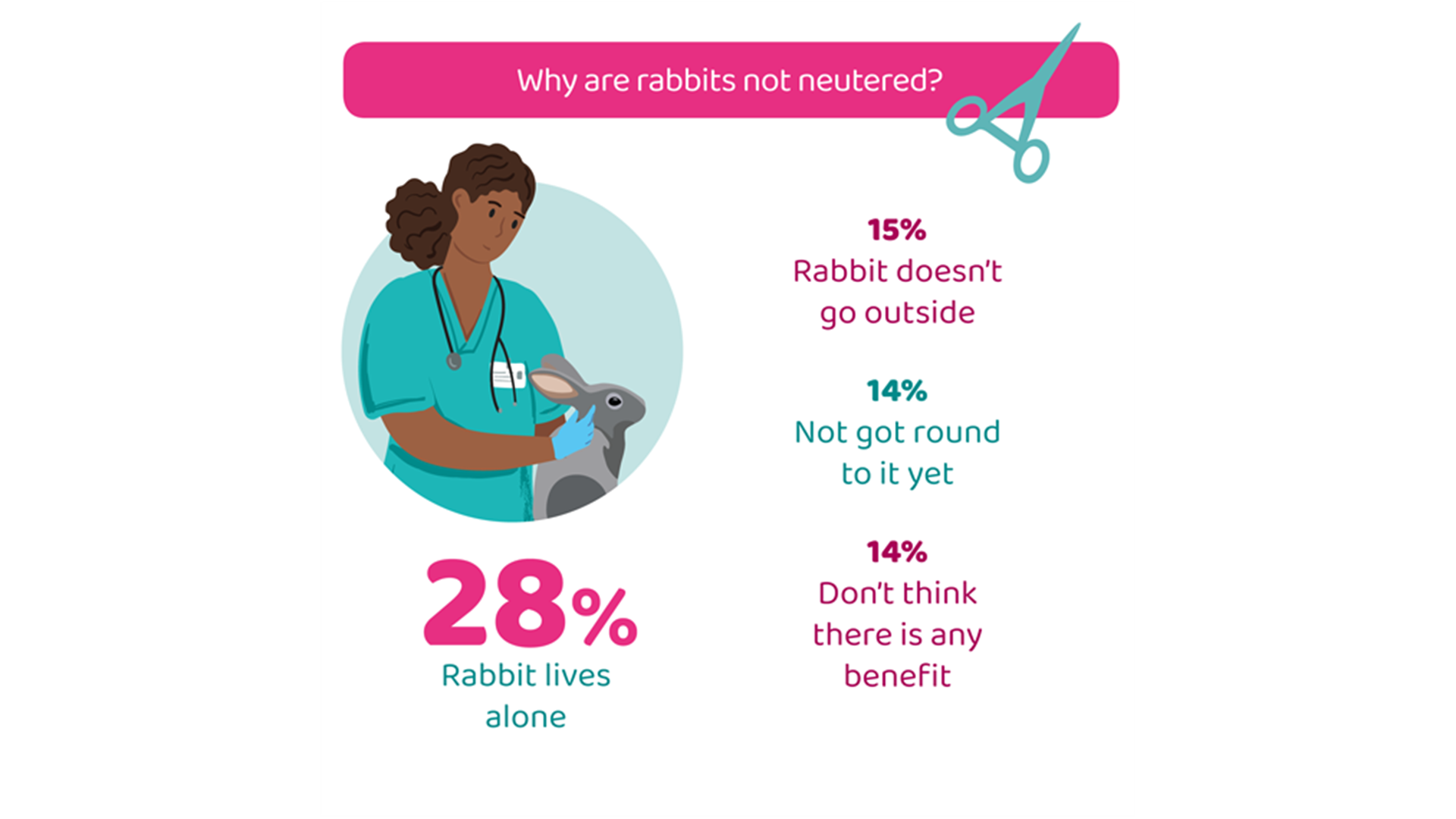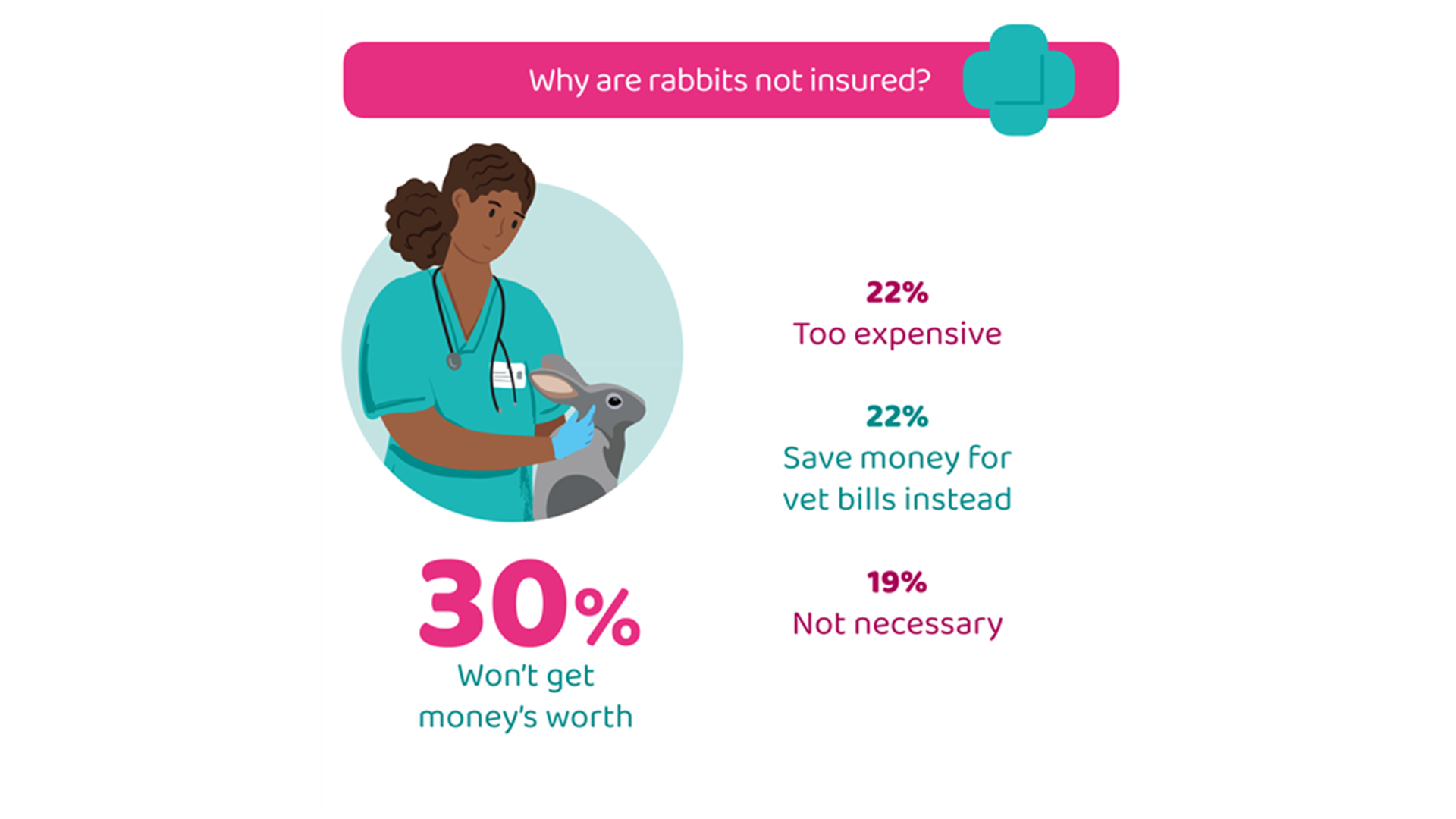Rabbits
As in previous years, a large proportion of rabbits are not having their welfare needs met. Owners’ lack of awareness of the welfare needs of rabbits continues to be of concern to veterinary professionals, who selected the following as the five most important welfare issues that need to be addressed for rabbits:


A complete lack of care has been one of the top welfare concerns of veterinary professionals since we first asked the question in 2014, together with inappropriate diet and inadequate housing. In many cases, it appears that rabbits may still be perceived as a low maintenance pet and often chosen as a pet for children, despite their complex husbandry requirements. It is essential that owners receive education when they acquire their rabbits on how to care for them and are supported to continue to appropriately provide for their 5 Welfare Needs throughout their lives. PDSA has worked with other organisations to create a non-statutory Welfare Code for Rabbits to help owners understand their pets’ needs; further awareness of this code amongst rabbit owners is needed.
Diet and Nutrition
42% of veterinary professionals identified an inappropriate diet as one of the five most important welfare issues that need to be addressed for rabbits. 13% of owners feed muesli mix as one of the main types of food their rabbit eats. These diets have been implicated in a variety of health problems, including obesity, dental disease and gastrointestinal disease32,33. Encouragingly, this proportion has continued to decrease since 2017, when it was 25%. However, 150,000 rabbits are still being fed a diet which could have adverse effects on their health.
Only 73% of owners told us that they feed hay as one of their rabbits’ main foods, a figure which has been relatively stable over the last seven years. Hay should make up the majority of a rabbit’s diet - inadequate hay provision is associated with rabbit obesity34 and affects their ability to express some of their natural behaviours35, primarily their need to spend a large proportion of their time grazing and feeding.
When choosing their pet’s food, rabbit owners were more likely to stick to the brand they’ve always bought (42%) than dog owners (34%). They were also more likely to seek advice from a vet or vet nurse (33%) than cat owners (23%), or to seek advice from animal welfare charities (21%) compared to dog (6%) and cat (7%) owners.
Rabbit owners were also more likely to seek the advice of animal welfare charities when deciding how much to feed their pet (6%) than dog (2%) or cat (1%) owners, and more likely to seek advice from a vet or other veterinary professional (17%) compared to cat owners (12%). 18% of rabbit owners relied on common sense, and 14% on past experience with pets. Easily accessible information is essential to continue to educate owners on the appropriate diets to choose for their rabbits.
Obesity in rabbits remains a concern for veterinary professionals, who, on average, estimate that 32% of rabbits are overweight or obese. 10% selected it as one of the top five welfare issues that need to be addressed for rabbits. Obesity in rabbits increases the risk of heart disease, arthritis, liver disease, flystrike, and skin problems such as urine scald and infections36.
Awareness of their pet’s weight and body condition score is a valuable tool for owners to manage their pet’s weight37. 37% of rabbit owners know their pet’s current weight, a lower proportion than for dog (68%) and cat (47%) owners, and 19% know their pet’s current body condition score. Rabbit owners (30%) were less likely to know their pet’s ideal weight compared to dog (56%) and cat (36%) owners. 70% of rabbit owners told us they had weighed their rabbit within the last 12 months, lower than for dog owners (91%).
When deciding if their pet is the correct weight, 44% of rabbit owners rely on advice from their vet or vet nurse, a lower proportion than for either cat (53%) or dog (57%) owners. 36% of owners look at their pet’s body, 30% use common sense, and 30% rely on the feel of their pet’s body. Only 18% weigh their pet to decide whether they are the correct weight, a lower proportion than dog owners (41%).
52% of rabbit owners told us they chose to give their rabbit a treat to provide variety for them, 45% because it makes their rabbit happy, 29% because it makes the owner happy, and 24% as part of their daily diet. 15% use treats to occupy their pet when they aren’t there, and 11% to distract them.
Companionship and Environment
Rabbits are highly social animals and should always live with another compatible rabbit companion where possible38. This year, 42% of rabbits live alone, with a further 5% living with another species of animal, meaning that an estimated 530,000 rabbits (48%) are still not having their companionship needs met appropriately. While this proportion has improved since the first PAW Report in 2011 (when 67% of rabbits lived alone), this trend has not continued since February 2020. Concern for the companionship needs of rabbits is reflected in our veterinary professional survey, with 36% of respondents identifying ‘lack of an appropriate companion’ as one of the top welfare issues for rabbits.
51% of rabbits (560,000) live predominantly inside their owner’s house, a higher proportion than in August 2020, when 39% of rabbits did so. Whether living inside or out, rabbits need to have the space to stretch, jump, run and dig39. Smaller hutches or cages simply don’t allow for these natural behaviours, making them unsuitable accommodation. We found that 22% of rabbits live in inadequate housing (small hutches with minimal or no run space). This proportion had improved since 2018, when 28% were kept in this way. However, 250,000 rabbits still do not have the space to exhibit normal behaviours. The proportion of rabbits living in unsuitable housing was similar for both the indoor (10%) and outdoor (12%) environments.
Over a third of veterinary professionals identified inadequate space for exercise (34%), and 31% chose small hutches as two of the top five welfare issues that need to be addressed for rabbits. The Welfare Code for Rabbits provides guidance on suitable accommodation, and the “Hutch is not Enough” campaign by the RWAF (Rabbit Welfare Association & Fund) is working to increase owner awareness of the environmental needs of their rabbits.

Preventive Health
In 2023, 43% of rabbits are not neutered (470,000 rabbits). This proportion has not changed over the last 7 years. Neutering provides health benefits, particularly for female rabbits40, as well as allowing rabbits of the opposite sex to live together without the risk of unwanted litters. 28% of owners whose rabbit was not neutered told us it was because they lived alone, and 15% because their rabbit didn’t go outside. 14% told us they didn’t see any benefit to the procedure, and 14% said they had not got around to it yet. Rabbits can breed from three months of age41, so any delay in neutering male and female rabbits kept together could result in accidental pregnancies, a concern raised by rehoming organisations who are currently struggling with the demand from owners needing to rehome unplanned litters42.
In the UK, rabbit vaccines are available against myxomatosis and rabbit (viral) haemorrhagic disease (R(V)HD). 52% of rabbits have received regular booster vaccinations, leaving 48% (530,000 rabbits) vulnerable to these common and often fatal diseases. 36% of owners whose rabbits had not received booster vaccinations told us it was because their rabbit doesn’t come into contact with other rabbits, and 29% because their rabbit doesn’t go outside – as both viruses can be spread through insect bites, these rabbits are still vulnerable to the diseases so should receive vaccine protection. R(V)HD is a significant concern, particularly with the emergence of a new strain in recent years – 22% of veterinary professionals reported that they had seen an increase in R(V)HD cases in rabbits over the last two years.

20% of rabbits are microchipped, which had decreased further from 2021, when it was 29%. 28% of those who had not microchipped their rabbit said it was because they felt their pet was unlikely to stray, and 27% said their pet doesn’t go outside.
20% of rabbits are insured, a much lower proportion than either cats (39%) or dogs (61%). 30% of owners who do not have their rabbits insured said it was because they didn’t think they would get their money’s worth, which was a higher proportion than either dog (22%) or cat (23%) owners. 22% said it was too expensive (a lower proportion than either dog –38%, or cat owners – 41%), and 22% said they save money for vet bills instead.
70% of rabbits are currently registered with a vet – this proportion is not significantly different from the last seven years.
31% of veterinary professionals identified inadequate routine rabbit healthcare, including preventive care, as one of the top welfare issues affecting rabbits in the UK in 2023. 9% of rabbit owners reported that their rabbits hadn’t received any of the preventive care options, a higher proportion than either cats (1%) or dogs (1%).
Key findings about rabbits from our 2023 PAW Report
 Video found at youtu.be/Fi3yhpXb4f0
Video found at youtu.be/Fi3yhpXb4f0

Footnotes
32 Meredith, A. L., Prebble, J. L., & Shaw, D. J. (2015). Impact of diet on incisor growth and attrition and the development of dental disease in pet rabbits. Journal of Small Animal Practice, 56(6), 377-382
33 Meredith, A. L., & Prebble, J. L. (2017). Impact of diet on faecal output and caecotroph consumption in rabbits. Journal of Small Animal Practice, 58(3), 139-145
34 Adji, A. V., Pedersen, A. Ø., & Agyekum, A. K. (2022). Obesity in pet rabbits: A narrative review. Journal of Exotic Pet Medicine.. 41, 30-37
35 Stapleton, N. (2021). Guide to behavioural issues in rabbits. In Practice, 43(1), 18-25
36 Stapleton, N. (2014). The chubby bunny: a closer look at obesity in the pet rabbit. The Veterinary Nurse, 5(6), 312-319
37 Laflamme, D. (2015). Why the Concern Over Obesity: An Introduction. Companion Animal Nutrition Summit, 1-4
38 Burn, C. C., & Shields, P. (2020). Do rabbits need each other? Effects of single versus paired housing on rabbit body temperature and behaviour in a UK shelter. Animal Welfare, 29(2), 209-219
39 McBride E.A., Magnus E., Hearne G. 2004. Behaviour problems in the domestic rabbit. In: Appleby D. (ed). The APBC Book of Companion Animal Behaviour. Souvenir Press Ltd., London, UK, 164-182
40 Richardson, V. (2012). Urogenital disease in rabbits. In Practice, 34(10), 554-563
41 McClure, D. (2022) MSD Veterinary Manual. Breeding and reproduction of rabbits https://www.msdvetmanual.com/all-other-pets/rabbits/breeding-and-reproduction-of-rabbits
42 RSPCA (2022) RSPCA reports huge influx of rabbits as charity sees intake rise by a THIRD in a year https://www.rspca.org.uk/-/news-influx-of-rabbits













